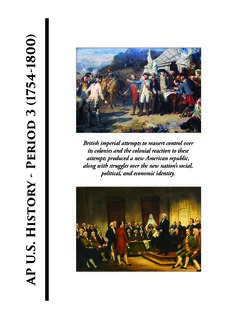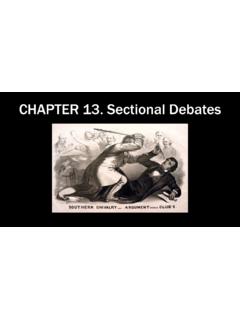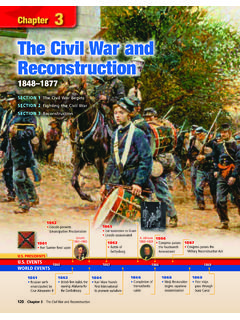Transcription of Guided Reading & Analysis: The Union in Peril, 1848-1861 ...
1 THIS IS AN OPTIONAL BONUS ASSIGNMENT. PRINT AND COMPLETE IN INK. Name:_____ Class Period:____ Due Date:___/____/____. Guided Reading & Analysis: The Union in Peril, 1848-1861 . chapter 13- Sectionalism Propelling the Nation into Civil War pp 247-261. Reading Assignment: Ch. 13 AMSCO other source covering Period 5. Purpose: This guide is not only a place to record notes as you read, but also to provide a place and structure for reflections and analysis using your noggin (thinking skills) with new knowledge gained from the Reading . Mastery of the course and AP exam await all who choose to process the information as they read/receive. This is an optional assignment. So young Jedi what is your choice? Do? Or do not?
2 There is no try. (image from released College Board exam). Directions: 1. Pre-Read: Read the prompts/questions within this guide before you read the chapter . 2. Skim: Flip through the chapter and note titles and subtitles. Look at images and read captions. Get a feel for the content you are about to read. 3. Read/Analyze: Read the chapter . If you have your own copy of AMSCO, Highlight key events and people as you read. Remember, the goal is not to fish for a specific answer(s) to Reading guide questions, but to consider questions in order to critically understand what you read! 4. Write Write (do not type) your notes and analysis in the spaces provided. Complete it in INK! Key Concepts FOR PERIOD 5: Key Concept : The United States became more connected with the world, pursued an expansionist foreign policy in the Western Hemisphere, and emerged as the destination for many migrants from other countries.
3 Key Concept : Intensified by expansion and deepening regional divisions, debates over slavery and other economic, cultural, and political issues led the nation into civil war. Key Concept : The Union victory in the Civil War and the contested reconstruction of the South settled the issues of slavery and secession, but left unresolved many questions about the power of the federal government and citizenship rights. Section 1 Guided Reading , pp 247-260. 1. Intro: The Union in Peril, 1848-1861 page 247. Key Concepts &. Main Ideas Notes Intensified by Read the Abraham Lincoln quote and first paragraph of the chapter on page 247. expansion and List and explain the four main reasons historians agree on that propelled the nation into civil war.
4 Deepening regional divisions, debates 1). over slavery and other economic, 2). cultural, and political issues led the nation into civil war. 3). 4). Which cause do you view as the most significant? 2. Conflict Over Status of Territories pp 247-248. REMEMBER As you read the chapter , jot down your notes in the middle column. Consider your notes to be elaborations on the Objectives and Main Ideas presented in the left column and in the subtitles of the text. INCLUDE IN YOUR NOTES ALL SIGNIFICANT VOCABULARY AND. PEOPLE. After read and take notes, thoughtfully, analyze what you read by answering the questions in the right column. Remember this step is essential to your processing of information. Completing this guide thoughtfully will increase your retention as well as your comprehension!
5 Key Concepts & Main Ideas Notes Analysis Conflict Over Status of Territories The Mexican-American War ended in 1848. What was the impact of the Mexican Cession on The institution American politics? of slavery and its attendant ideological Free-Soil Movement . debates, along with regional economic and demographic changes, Southern Position . territorial expansion in How was the impact of the Mexican Cession in the 1840s and 1848 similar to the impact of the Louisiana 1850s, and Purchase in 1803? Make sure your answer cultural includes specific evidence connecting the differences Popular Sovereignty broad context of both events. between the North and the South, all intensified sectionalism. Election of 1848 . 3.
6 The Compromise of 1850, pp 248-249 (this is a major event in the framework make sure you thoroughly understand it!). Key Concepts & Main Ideas Notes Analysis The Compromise of 1850 What was the most contentious aspect of this compromise? Explain and defend Repeated attempts your answer. at political compromise failed to calm tensions over slavery and often made sectional tensions worse, breaking down the trust between sectional leaders and culminating in the bitter election of 1860, followed by the secession of southern states. National leaders made a variety of proposals to resolve the issue of slavery in the territories, including the Compromise of 1850 . Before the Compromise of 1850. This compromise took several months to hammer out.
7 One of the most famous speeches regarded this crisis. Peaceable secession! Peaceable secession! The concurrent agreement of all the members of this great republic to separate! A voluntary separation, with alimony on one side and on the other. Why, what would be the result? Where is the line to be drawn? What States are to seceded? What is to remain American? What am I to be? An American no longer? Am I to become a sectional man, a local man, a separatist, with no country in common with the gentlemen who sit around me here, or who fill the other house of Congress? Heaven forbid! Where is the flag of the republic to remain? Where is the eagle still to tower? Or is he to cower, and shrink, and fall to the ground?
8 Why, Sir, our ancestors, our fathers and our grandfathers, those of them that are yet living amongst us with prolonged lives, would rebuke and reproach us; and our children and our grandchildren would cry out shame upon us, if we of this generation should dishonor these ensigns of the power of the government and the harmony of that Union which is every day felt among us with so much joy and gratitude.. Seventh of March Speech, Daniel Webster, 1850. After the Compromise . 4. Agitation Over Slavery, pp 249-251. Key Concepts & Main Ideas Notes Analysis The institution of slavery Agitation Over Slavery Explain how abolitionists and its attendant impacted state institutions and ideological debates, along American culture.
9 With regional economic and demographic Fugitive Slave Law . changes, territorial expansion in the 1840s and 1850s, and cultural differences between the North and the South, all Enforcement and Opposition . intensified sectionalism. The North's expanding economy and its increasing reliance on a free-labor manufacturing economy contrasted with the Underground Railroad . South's dependence on an Explain how the arts impacted economic system movements for social and characterized by slave- political change in the based agriculture and Antebellum Era. slow population growth. Books on Slavery Pro and Con National leaders made a variety of proposals to Uncle Tom's Cabin . resolve the issue of slavery in the territories, including the Compromise of 1850.
10 And the Kansas . Nebraska Act. Abolitionists, although a Did you know what an Uncle Tom is? Uncle Tom, the title character, was initially seen minority in the North, as a noble, long-suffering Christian slave. In more recent years, however, his name has become an epithet directed towards African-Americans who are accused of selling out' to mounted a highly visible whites. Stowe intended Tom to be a "noble hero and praiseworthy person. Throughout the campaign against slavery, book, far from allowing himself to be exploited, Tom stands up for his beliefs and is adopting strategies of grudgingly admired even by his enemies. resistance ranging from fierce arguments against Impending Crisis of the South . the institution and Horace Greely(an abolitionist who also started the New York assistance in helping Tribune; a very influential slaves escape to newspaper) distributed willingness to use violence Impending Crisis of the South to achieve their goals.








